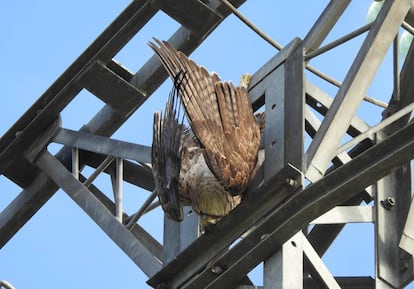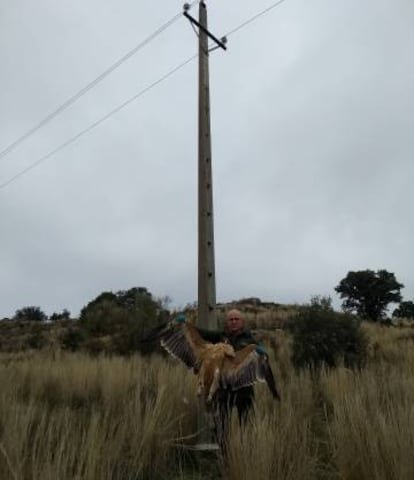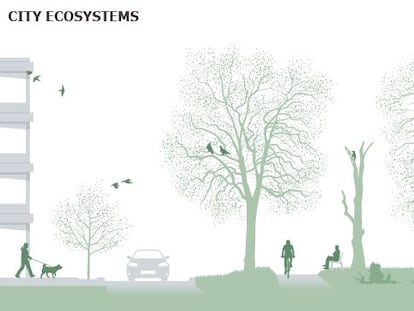“It is truly a massacre” – How power lines are killing Spain’s birds
The public prosecutor is pushing regional authorities to do more to help the thousands of animals who die every year from being electrocuted in electricity cables


Imperial eagles, bustards, storks, eagle owls, bearded vultures and Bonelli’s eagles; it is almost impossible to find a species of bird, particularly birds of prey (many of them protected), which have not met their end on the power lines responsible for thousands of deaths every year in Spain.

The public prosecutor has described the numbers as “intolerable” and has sent a missive to the regions criticizing their passive response to the problem. The regional authorities are being accused of not bringing disciplinary action against the owners of the electricity cables and even obstructing the work of the environmental agencies that process complaints after finding the bodies of the birds.
“It is truly a massacre,” says Ernesto Álvarez, president of the Group for the Rehabilitation of Indigenous Fauna and its Habitat (Grefa), which is dealing on a daily basis with the issue as they monitor the electricity cables around the country.
Esaú Escolar, vice president of the Spanish Association for Environmental and Forestry Agents (Aeafma), which does similar work in the region of Castile and León, agrees, adding that the authorities “throw a lot of obstacles in the way” when it comes to fining the owners of the power cables.
The missive sent last week to the regional authorities was drawn up by the Environment and Urban Planning Department’s prosecutor, Antonio Vercher. The department opened a case on the matter in 2017. But, after several years asking the regional authorities for information, the conclusion has been that, “apart from admirable exceptions, it can be said that the authorities have not initiated competent disciplinary action to find out the potential legal significance of the death of bird life by electrocution or collision with the electricity cables.”
The public prosecutor also points out that in order to justify the lack of action, some authorities have said that they consider these deaths to be accidents so, in their opinion, disciplinary action has not been an option. According to the document accessed by EL PAÍS, others allege that the electricity companies have agreed to fix the defective cables, meaning they are unable to take disciplinary action.
According to a report, 33,000 birds of prey die each year because of electricity wires
However, the public prosecutor refutes these arguments and points out that in the province of Albacete, in the central Castile-La Mancha region, the authorities have brought disciplinary action in such cases and the courts have sided with them on six occasions.
The public prosecutor also refers to the lack of resources, both human and material, in the recovery centers, which say the number of birds killed by electrocution and collision is “alarmingly high.”
According to a report from the previous Environment Ministry, 33,000 birds of prey die each year because of electricity wires, while another study by the Friends of the Imperial Eagle Foundation put the total number of bird deaths between 192,000 and 337,000.
English version by Heather Galloway.
Tu suscripción se está usando en otro dispositivo
¿Quieres añadir otro usuario a tu suscripción?
Si continúas leyendo en este dispositivo, no se podrá leer en el otro.
FlechaTu suscripción se está usando en otro dispositivo y solo puedes acceder a EL PAÍS desde un dispositivo a la vez.
Si quieres compartir tu cuenta, cambia tu suscripción a la modalidad Premium, así podrás añadir otro usuario. Cada uno accederá con su propia cuenta de email, lo que os permitirá personalizar vuestra experiencia en EL PAÍS.
¿Tienes una suscripción de empresa? Accede aquí para contratar más cuentas.
En el caso de no saber quién está usando tu cuenta, te recomendamos cambiar tu contraseña aquí.
Si decides continuar compartiendo tu cuenta, este mensaje se mostrará en tu dispositivo y en el de la otra persona que está usando tu cuenta de forma indefinida, afectando a tu experiencia de lectura. Puedes consultar aquí los términos y condiciones de la suscripción digital.
More information
Archived In
Últimas noticias
Half of Scotland is in the hands of 420 property owners
Reinhard Genzel, Nobel laureate in physics: ‘One-minute videos will never give you the truth’
Pinochet’s victims grapple with José Antonio Kast’s rise in Chile
From digital curfews to blocking apps: How technology experts protect their children online
Most viewed
- Pablo Escobar’s hippos: A serious environmental problem, 40 years on
- Reinhard Genzel, Nobel laureate in physics: ‘One-minute videos will never give you the truth’
- Why we lost the habit of sleeping in two segments and how that changed our sense of time
- Charles Dubouloz, mountaineering star, retires at 36 with a farewell tour inspired by Walter Bonatti
- The Florida Keys tourist paradise is besieged by immigration agents: ‘We’ve never seen anything like this’










































